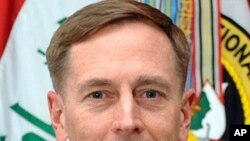The U.S. and international commander in Afghanistan, General David Petraeus, who took command a month ago, has issued his first guidance document for the nearly 150,000 troops under his command. He is emphasizing the need to provide security and good governance for the Afghan people.
In a three-and-a-half-page document, General Petraeus' first two guidance points order his forces to "secure and serve the population" and "live among the people." His 24 points also include fighting corruption and abuse of power, which he says fuel the insurgency. He also tells the troops to "pursue the enemy relentlessly," to "fight hard" and also "with discipline," and to consult local people and their leaders as they make plans.
The document makes many of the same points as the one issued a year ago by Petraeus' predecessor, General Stanley McChrystal, who was forced to resign in June after he and members of his staff were quoted criticizing senior Obama Administration officials.
Petraeus also is expected to issue a new tactical directive - probably this week - designed to clarify some of McChrystal's orders, particularly one that some troops have complained limits their ability to call in air strikes to protect themselves. Senior officials say air strikes should be kept to a minimum to avoid civilian casualties, but Petraeus has already said troops must be allowed to defend themselves.
Speaking to a veterans' group Monday, President Barack Obama indicated the tactical directive will be well timed, as most of the additional forces he ordered to Afghanistan have arrived and operations are steadily increasing.
"Nearly all the additional forces that I ordered to Afghanistan are now in place," said the president. "Along with our Afghan and international partners, we are going on the offensive against the Taliban, targeting their leaders, challenging them in regions where they had free rein, and training Afghan national security forces."
The president said the United States and its coalition and Afghan partners "will continue to face huge challenges in Afghanistan," but he said the new strategy he announced in December is generating progress toward what he called "achievable" goals.
The key goals are to defeat al-Qaida and it supporters, including the Taliban, and to enable the Afghan government and security forces to keep the terrorists out in the future. The president says he will begin to withdraw U.S. troops next July, but officials say the United States will maintain a substantial military and civilian commitment to Afghanistan for years after that.
The guidance document General Petraeus issued Sunday tells the troops they need to work closely with the Afghan forces, and with U.S. and international civilian agencies. He also tells the troops it is important to gain the trust of the Afghan people by interacting with them and by communicating allied intentions, and the results of operations, quickly and accurately.
He also endorses the Afghan government's somewhat controversial plan to reintegrate some low-level Taliban fighters into society, saying the foreign troops should work with local officials to identify which insurgents are "reconcilable," and which need to be pursued militarily.
According to the Pentagon, there are now 98,000 U.S. troops in Afghanistan. That is the target number for the enhanced force ordered by President Obama. Officials say the number, however, reflects some overlap between newly arrived units and some that are preparing to rotate out of the country, and there still several thousand of the additional forces yet to deploy. The Pentagon says there also are 49,000 troops from NATO and other international partner countries.











